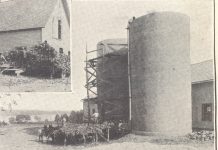How many readers have heard of the MacDonald car that was built in nearby Garfield, Ohio?
For that matter, how many have heard of Garfield (not Garfield Heights), Ohio?
Garfield is a tiny community of about twenty homes and a busy feed mill along Ohio State Route 534, right along the Norfolk Southern railroad a mile north of Damascus. When the railroad was built through Salem to Alliance and beyond in 1852, Garfield became an important stop on the line.
The railroad brought businesses to Garfield, including the Spear fruit packing house, the Quaker Valley Fruit Canning House, the Garfield Creamery Company, a brick yard and Tillman Hall’s steam-powered feed mill.
The MacDonald steam car was the brainchild of Duncan MacDonald who was born Dec. 19, 1881 in Sewickley, Pa.
Duncan’s father, Frank McDonald (Duncan seems to have used “Mac, while his father used “Mc”), ran a grain and feed store in Sewickley and then had a wholesale flour business in Pittsburgh. At some point, Frank McDonald moved to a farm on E. Main (State) St., Salem, Ohio, and also owned 165 acres on Garfield Road where he raised trotting horses. Young Duncan presumably grew up in the Salem-Damascus area, although it’s unclear where he went to school.
Duncan MacDonald probably had some engineering training and next turns up in Pittsburgh, Pa.
Here, in November, 1919, he and several others organized the Gearless Motors Corporation to manufacture steam cars. Apparently promotion of Gearless company stock was tireless, with $1,360,000 worth soon sold. MacDonald, who had several steam car patents to his credit, was president of the new company.
A 5-passenger touring car costing $2,600 and a 3-passenger roadster for $50 more were planned.
Reportedly, five Gearless cars had been built by November of 1920 when MacDonald suddenly resigned from the firm.
He left Pittsburgh and returned to Salem, where the 1923-24 City Directory lists him as living at 416 S. Union Avenue.
A circa-1920 stock prospectus for the new MacDonald firm bragged, “An ideal factory acreage at Garfield, Ohio on the main line of the Pittsburgh, Ft. Wayne and Chicago Ry., and near the Stark Electric Ry. between Salem and Alliance was secured months ago. A substantial shop and office building has been constructed and is being equipped with modern production machinery. Patterns have been rushed and work is already underway and in a few months the company should be producing and earning most interesting profits.
“Never was a future brighter, for in resigning as President of the Gearless Motor Corporation last September Mr. MacDonald did so with the determination of building a better car, one which could be marketed at a popular price and maintained without financial embarrassment by the most frugal owner.”
Even at the time when steam vehicles were swiftly fading from popularity, MacDonald seems to not have believed it.
The prospectus goes on: “It is estimated that it will take fifty Steam Car Builders five years to satisfy fifty per cent of those interested in, and in a position to purchase Steam Cars, Trucks and Tractors.”
MacDonald wasn’t just interested in cars — the prospectus claimed that “MacDonald’s cars, trucks and tractors are being designed to meet the future demands of the American Nation,” and one of his patents is for a gear reduction in his drive mechanism to make it suitable for heavy-duty vehicles.
MacDonald built at least a couple of cars, a photo exists of him standing with one foot on the running board of a MacDonald sedan with the hood up showing three men the boiler under the hood.
The sedan was virtually identical to the Pittsburgh Gearless car, which is to be expected as both were based largely on Duncan MacDonald’s patents.
Advertising for the car claimed to offer these advantages: “No Spark Plugs. No Carburetor. No Magneto. No Fly Wheel. No Clutch. No Racing of Motor. No Gears to Shift. No Propellor Shaft. No Self Starter. No Distributor. No Vibration. No Differential Gears. No Complex Electric Wiring.”
It did have: a 20 inch by 16 inch fire tube boiler, a 4-cylinder engine connected directly to the rear wheels, a vaporising type burner, fm and tube condenser, balanced pumps, releasing type throttle, and it burned kerosene and other “Distolates” (sic).
MacDonald believed he had the “smoothest and most powerful vehicle for its weight in America.”
MacDonald also planned to make a smaller, 2-seater roadster called the “Bobcat,” with an estimated price of $750 to $1,000.
This car had a 3-cylinder engine and one drawing shows the vertical engine mounted amidships the car with a conventional rear differential and drive shaft, whereas in the Gearless, and the larger MacDonald, the 4-cylinder engine was mounted horizontally at the rear of the machine with a direct drive that used the rear axles as the engine crankshafts. On these cars, the two cylinders on the right side drove the right wheel and vice-versa, thus eliminating the need for a differential.
Although MacDonald had claimed that “Practically unlimited capital (was) behind the (MacDonald car),” nothing much ever came of it. A prototype or two was undoubtedly built, but there’s no record of any ever being sold.
Then, there was another problem.
In May of 1923, MacDonald and three other officers of the ill-fated Gearless company were indicted for conspiracy and mail fraud in the Gearless stock sale scheme. The next year, MacDonald and two others were found guilty.
I don’t know if he ever served time, but that was the last that was heard of the Garfield built MacDonald steam car, although there apparently had been a number of conversion kits sold to turn gasoline cars into steamers.
The man didn’t give up though.
In Chicago in 1930, he and a man named Jeffrey Carqueville converted a 1930 Nash to steam and called it the Cardon. Carqueville drove the car to New York to attract investors, but when no one was interested, the project was abandoned.
A 1936 MoToR magazine notes that MacDonald was in Los Angeles making steam conversion kits, again, I imagine, with little success.
Duncan MacDonald ended up in New Orleans, where he died in January of 1944, was brought back to Salem, and now rests in peace in Grandview Cemetery.
(Send suggestions, comments or questions to Sam Moore in care of Farm and Dairy, P.O. Box 38, Salem, OH 44460-0038; or via e-mail to: editorial@farmanddairy.com.)












